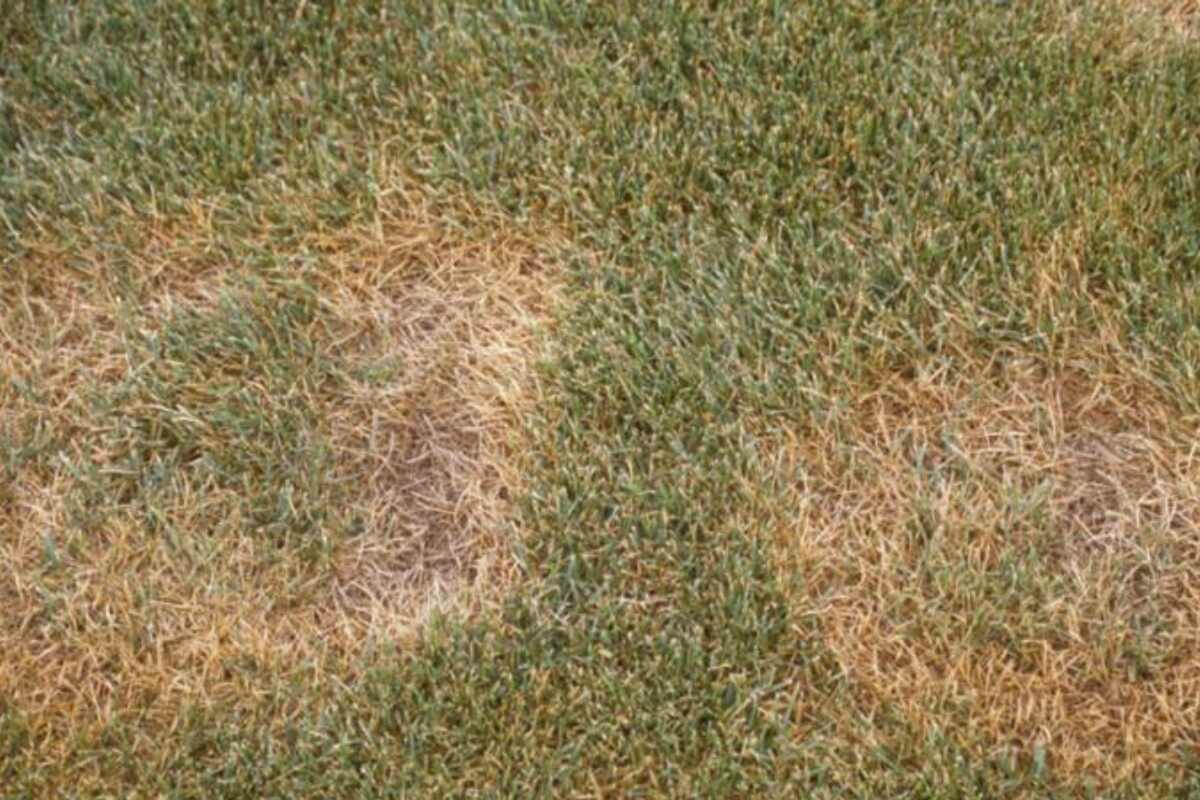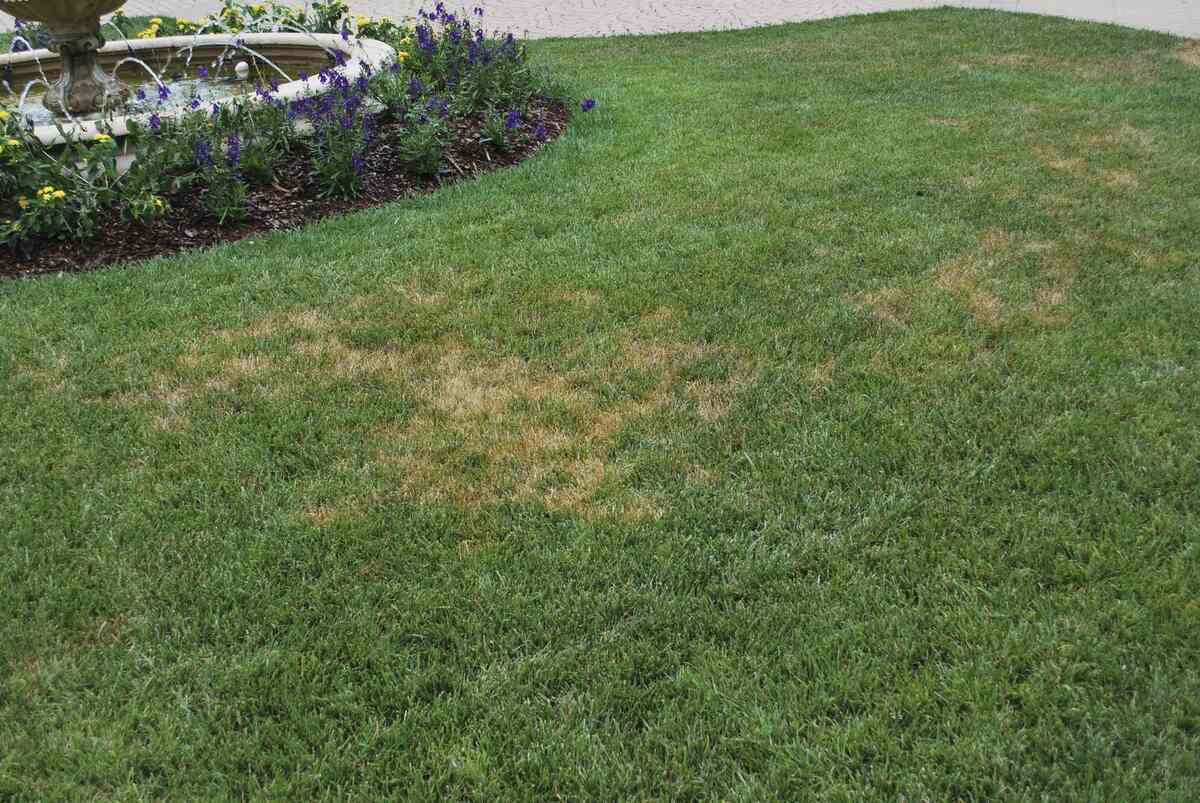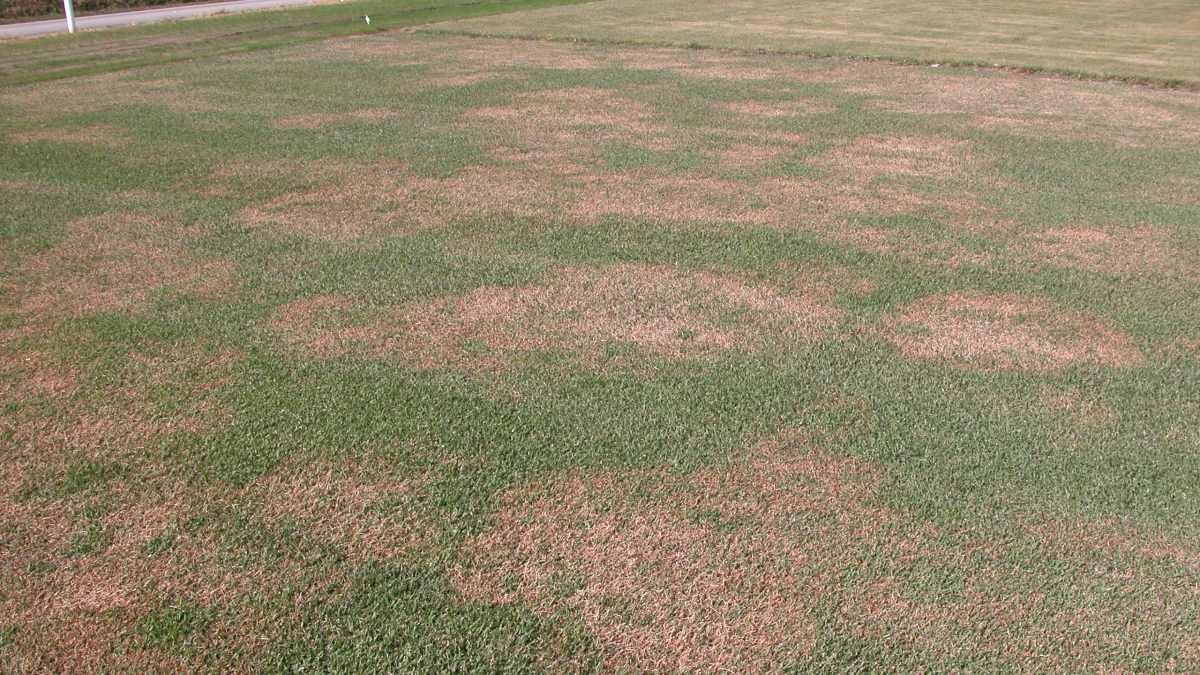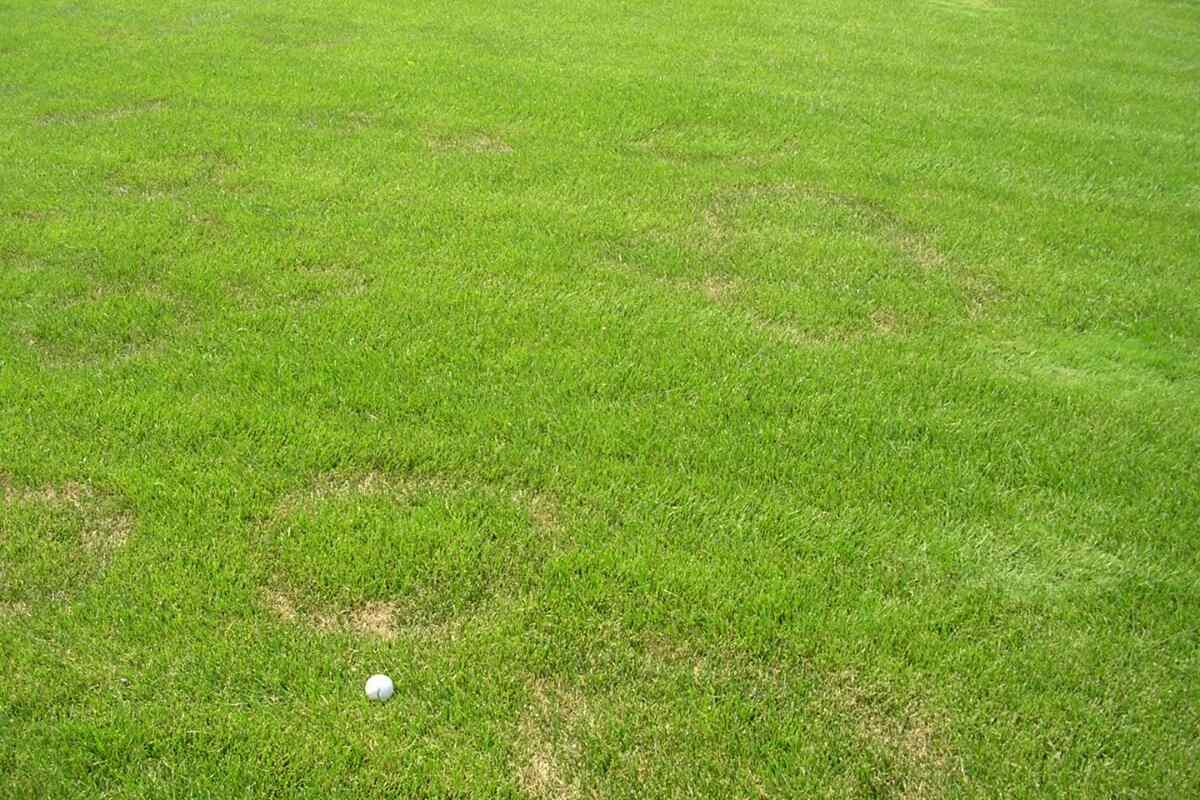
Fusarium blight is a fungal disease that appears on cool-season lawns when it’s hot and humid and your grass is water-stressed. It shows up as small circular patches with healthy and dead grass rings, looking like frog eyes.
In this article, we’ll show you how to identify, control, and prevent this fungal disease.
What is Fusarium Blight?
Fusarium blight is a disease that affects turfgrasses and is caused by the fungi Fusarium roseum and Fusarium tricinctum.
It is commonly found in cool-season grasses when it’s hot and humid during the summer, especially if a lawn is experiencing water or drought stress. This lawn disease appears as circular patches of dead grass with healthy grass in the center, giving it a frog-eye appearance. .
Once infected, grass can die in as little as 4 to 7 days after the first Fusarium blight symptoms appear.
And how can you prevent Fusarium blight? Regular lawn care is the best way to head off these patches in your grass.
How to Identify Fusarium Blight in Lawns
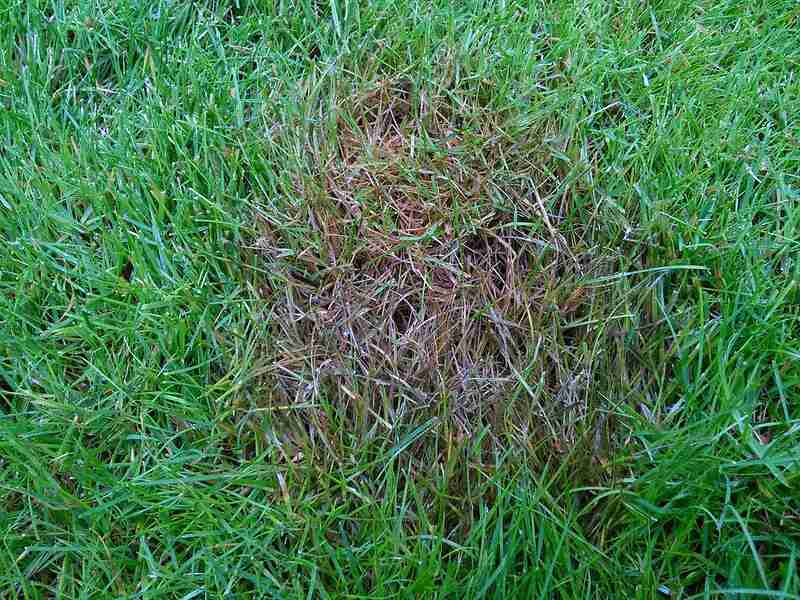
Fusarium blight has two distinct stages, leaf blighting and root rot, so the symptoms morph as the disease gains ground in your lawn.
It first appears scattered across your grass as small, circular light green or grayish-green patches. Early on, the patches are typically 2 to 6 inches in diameter but can grow up to three feet across. These patches may look like frog eyes or donuts—the plants in the center may be healthy and unaffected, surrounded by a border of infected grass.
If conditions are favorable, the patches change to a dull reddish brown within 36 to 48 hours and then fade to straw-colored. They’ll have brown margins, and you’ll see lesions and streaks of brown on the grass blades. The crown of the dead grass will become hard and tough.
As the pathogen affects the roots, the grass will become stunted. A brown to reddish-brown dry rot takes place in the roots and may extend to the crown of the grass. The roots continue to darken in appearance as Fusarium fungi colonize the soil, feeding on the roots as they decompose.
You might also see a layer of pink mycelium at the base of the grass near the soil surface if soil moisture levels are high. Mycelium is made up of thin threads and looks like a cloudy or spider-web-like substance.
Grasses Susceptible to Fusarium Blight
Fusarium blight typically affects several cool-season grasses during warm weather conditions, but you may also see problems in warm-season turfgrasses.
Fusarium blight most often occurs in Kentucky bluegrass, bentgrasses, red fescue, tall fescue, and centipedegrass.
The Kentucky bluegrass cultivars ‘Park,’ ‘Campus,’ ‘Fylking,’ and ‘Nugget’ are the most susceptible to damage from Fusarium blight. New KBG cultivars such as ‘Adelphi,’ ‘Bonnieblue,’ ‘Geronimo,’ ‘Majestic,’ ‘Parade,’ and ‘Rugby’ have been bred to be much less susceptible.
Conditions That Promote Fusarium Blight
Conditions that encourage Fusarium blight development include:
- High daytime temperatures (80 to 95°F)
- High nighttime temperatures (70°F and above)
- High humidity levels
- Excessive thatch layer
- Compacted soil
- Dry soils (close to the permanent wilting point)
- Pure stands of turf susceptible to the disease without a resistant grass type mixed in
- Sodded lawns put down over heavy clay soils
- Turf near paved areas that increase heat and drought
- Southern exposures where the grass dries out quickly in the full sun
- Abundance of soluble nitrogen during the summer
- Calcium deficiency in the soil
See the list of best lawn care practices above to prevent these conditions and the spread of Fusarium blight on your lawn.
Can You Control Fusarium Blight?
If you have Fusarium blight in your grass, you can turn to fungicide applications, but chemical control has little impact if you’re not following good cultural practices. In this case, preventing the disease by maintaining the health and vigor of your turf is your best bet since these fungi attack weakened turf.
The best lawn fungicides for killing active Fusarium blight fungi include:
- Banner Maxx
- Heritage Maxx (aka Heritage G)
- Propiconazole 14.3
- Eagle 20EW
- Cleary 3336F
- Fertilome F-Stop
- Pillar G
- Scotts Disease EX
- Bayleton
- Chipco 26019
Best Lawn Care Practices to Prevent Fusarium Blight
As I said earlier, the best way to control Fusarium blight is to prevent it in the first place by maintaining robust and healthy grass. The following lawn care practices will help your lawn resist infection by Fusarium blight and other diseases:
- Follow recommended watering amounts for your grass type, and water infrequently yet deeply to avoid moisture stress. Most lawns need about 1 – 1.5 inches of water per week, no more and no less.
- Set your lawn mower deck at the highest recommended height for your grass type. And never take off more than one-third of the height when mowing.
- Dethatch your lawn once the thatch layer is over half an inch thick to improve airflow. Good air circulation is vital in preventing all lawn diseases.
- Aerate your lawn as needed to minimize soil compaction and improve drainage, thus reducing moisture buildup. Most lawns only need to be aerated once every few years, but especially heavy, thick soil may need aeration once a year or more.
- Have your soil tested every couple of years to check the nitrogen levels and adjust them as needed by adding soil amendments.
- Follow proper nitrogen fertilization guidelines for your soil (based on soil test results and grass type) to avoid over-applying nitrogen.
- Overseed highly susceptible grasses with resistant varieties or add up to 20% perennial ryegrass.
- Apply a preventative fungicide as conditions become favorable for spore production (i.e., when temperatures stay over 70°F).
FAQ About Fusarium Blight
Is Fusarium Fungus Harmful to Humans?
According to a study conducted by the National Institutes of Health, ingestion of Fusarium mycotoxins can make humans and animals (such as your pets) more susceptible to certain infections. However, the same study notes that ingestion of these mycotoxins is “common and generally does not result in obvious intoxication.”
Can Fusarium Be Cured?
It is difficult, but not impossible, to eradicate Fusarium blight in your lawn. Fungicides such as the ones listed above can be helpful, but you will not achieve full control of the disease without proper lawn care practices.
Preventative fungicides are more effective than treatments applied after the fungus is already active, so it’s a good idea to apply fungicides before summer if your lawn has a history of Fusarium blight.
Does Fusarium Stay in the Soil?
Yes, Fusarium fungi can remain in soil, thatch, and other parts of your grass for several years. They go dormant and overwinter in your lawn when temperatures drop, then resume killing your grass the next summer.
Why is Fusarium Blight Confused with Other Lawn Diseases?
Up until about 40 years ago, many of the patch diseases afflicting Kentucky bluegrass were collectively called “fusarium blight” and were thought to be caused by crown infections of Fusarium fungi. However, pathology research has shown that summer patch, necrotic ring spot, and fusarium blight are three very different problems caused by different fungal strains.
Summer patch is caused by Magnaporthe poae and necrotic ring spot by Leptosphaeria korrae. All of these “patch diseases” exhibit similar symptoms because the resulting root rot stops the supply of adequate water and nutrients to the above-ground grass blades.
Fusarium blight isn’t to be confused with Fusarium patch, wilt, or rot. Different fungi cause each disease, and the symptoms appear in affected areas of your lawn differently, hence the different names.
When it comes to lawn diseases, you must determine what specific issue you’re dealing with before tackling it. Symptoms of different common lawn diseases can look similar, but their causes are different and require different treatments.
Hire a Lawn Care Pro to Help With Fusarium Blight
Lawn diseases can be stubborn. Once they’re in your grass, it takes time and dedication to get rid of them. If you’re struggling with a Fusarium blight infection or want help caring for your lawn to prevent this and other diseases, LawnStarter connects you to the best lawn treatment pros near you.
Pros have the experience to diagnose your lawn correctly and treat its problems effectively, and they have access to fungicides and other chemicals that aren’t available to the wider public. A pro can probably heal your lawn much quicker than you can on your own.
LawnStarter participates in the Amazon Services LLC Associates Program, an affiliate advertising program. LawnStarter may earn revenue from products promoted in this article.
Main Photo Credit: Aaron J. Patton, Ph.D. / Turfgrass Extension Specialist at Purdue University


